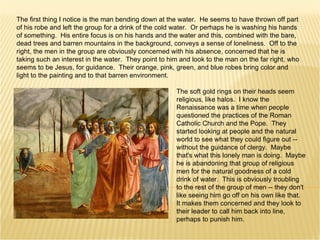
Lesson One - The Renaissance
- 1. The soft gold rings on their heads seem religious, like halos. I know the Renaissance was a time when people questioned the practices of the Roman Catholic Church and the Pope. They started looking at people and the natural world to see what they could figure out -- without the guidance of clergy. Maybe that's what this lonely man is doing. Maybe he is abandoning that group of religious men for the natural goodness of a cold drink of water. This is obviously troubling to the rest of the group of men -- they don't like seeing him go off on his own like that. It makes them concerned and they look to their leader to call him back into line, perhaps to punish him. The first thing I notice is the man bending down at the water. He seems to have thrown off part of his robe and left the group for a drink of the cold water. Or perhaps he is washing his hands of something. His entire focus is on his hands and the water and this, combined with the bare, dead trees and barren mountains in the background, conveys a sense of loneliness. Off to the right, the men in the group are obviously concerned with his absence, concerned that he is taking such an interest in the water. They point to him and look to the man on the far right, who seems to be Jesus, for guidance. Their orange, pink, green, and blue robes bring color and light to the painting and to that barren environment.
- 3. Italy failed to become united during the Ages. Many independent city-states emerged in northern and central Italy that played an important role in Italian politics and art. Milan Venice Florence Tyrrhenian Sea Adriatic Sea Milan One of the richest cities, it controls trade through the Alps. Venice Sitting on the Adriatic, it attracts trade from all over the world. Florence Controlled by the De Medici Family, who became great patrons of the arts. Genoa Genoa Had Access to Trade Routes All of these cities: Had access to trade routes connecting Europe with Middle Eastern markets • Served as trading centers for the distribution of goods to northern Europe • Were initially independent city-states governed as republics
- 4. The Renaissance was a time of renewal Renaissance means rebirth and Europe was recovering from the Dark ages and the plague. People had lost their faith in the church and began to put more focus on human beings.
- 5. The Renaissance produced new ideas that were reflected in the arts, philosophy, and literature. Patrons, wealthy from newly expanded trade, sponsored works which glorified city-states in northern Italy. Education became increasingly secular. Medieval art and literature focused on the Church and salvation Renaissance art and literature focused on individuals and worldly matters, along with Christianity.
- 6. 1 2
- 9. -People -Depth Perception - Perspective Vanishing Point - Religion - Artist